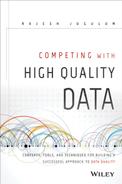Chapter 14
Building a Data Quality Practices Center
14.0 Introduction
Thus far, we have discussed building an effective DQ program and the methods, frameworks, and approaches that are essential for executing the program. In order to build these capabilities throughout a company, it is necessary to establish a strong DQ practices center (DQPC). The DQPC will have the operational capability to provide services, tools, and governance to deliver tangible insights and business value from the data. In this chapter, we describe the building of such a center with the required capabilities.
14.1 Building a DQPC
The target state objective for any data quality program should be to create a fully functional data quality practices center (DQPC). The DQPC will have the required capabilities and will offer services to assist various business functions and business units. The fundamental building blocks identified for the DQPC are shown in Figure 14.1, and they should be kept in mind throughout the evolution of the DQ program.
As shown in Figure 14.1, the DQPC will have four important components: enablers, governance, monitoring and improvements, and analytical insights. A brief description of each component is provided as follows.
- Enablers: This component is responsible for delivering DQ services such as standardizing the DQ toolset, supporting metadata, and conducting various DQ assessment activities, besides providing required DQ resources and expertise to accelerate DQ adoption.

Figure 14.1 End-to-End Data Quality Management with DQPC
- Governance: The primary responsibilities of this component include formalizing the data governance structure with focus on the standardization of various processes and analyses.
- Monitoring and improvements: This component includes control of CDE data including enterprise CDEs (if a CDE intersects more than one business process and is used in multiple applications, then it is referred to as an enterprise CDE) and associated business processes.
- Analytical insights: This component is responsible for conducting advanced analytics to produce data that can be used in various critical decision activities and computing business values associated with data quality.
The information provided in the previous chapters of this book will help companies come closer to achieving cohesive and enterprise-wide data quality capability. Companies can derive enormous benefits from identifying common enterprise problems and tracking them upstream to find the common root causes.
14.2 Conclusions
We can summarize the conclusions of this chapter as follows:
- This chapter highlights the importance of building out data quality capabilities with the end objective of creating a data quality practices center. Companies can derive significant benefits from having a centralized DQPC, as it helps to identify common enterprise problems and solve them through a systematic and standardized approach.
- Data quality needs to be managed throughout the enterprise with the help of a DQPC because data usage occurs simultaneously in many different business processes and common root causes can affect many users.
